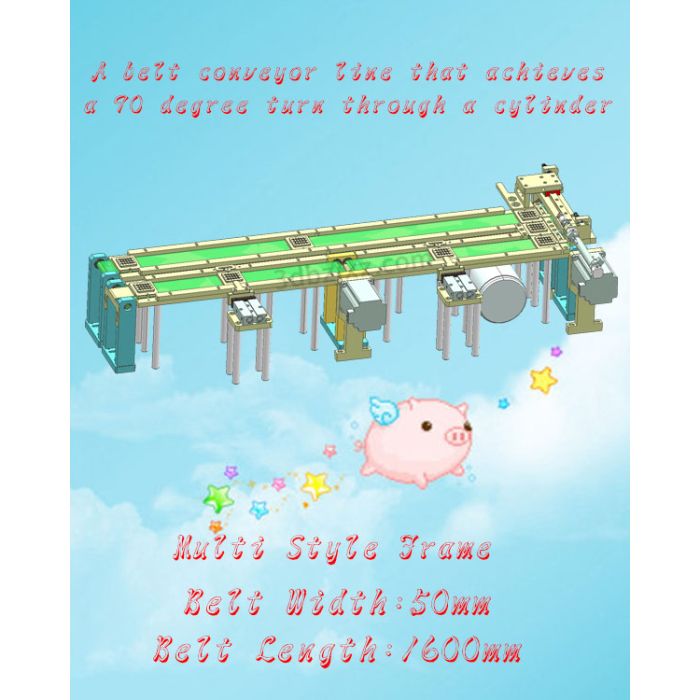beltconveyor_093_w50_l1600
- Stp samples download
- click to down
试用数据点击上方下载!
A belt conveyor line that achieves a 90 degree turn through a cylinder is a common design in industrial automation. It utilizes the linear motion of the cylinder to be converted into rotational motion through a specific mechanical structure, thereby achieving a 90 degree turn on the conveyor line. Here is a detailed introduction to this design:
1、 Working principle
The design principle of the cylinder 90 degree flipping mechanism mainly relies on the drive of the cylinder. When the cylinder receives a signal, its piston rod will extend or retract, and this linear motion is converted into rotational motion through mechanical structures such as connecting rods, gears, and turntables. When the rotation reaches 90 degrees, the cylinder stops moving through limit switches or sensors, thereby achieving a 90 degree turn of the conveyor line.
2、 Structural composition
Cylinder: A power source that provides linear motion, usually installed at the turning point of a conveyor line.
Connecting rod or gear transmission mechanism: converts the linear motion of the cylinder into rotational motion, usually including connecting rods, gears, bearings, and other components.
Rotary table: connected to the transmission mechanism to achieve the rotation of the conveyor line. Rotary tables are typically designed with sufficient strength and rigidity to support conveyor lines and the transported items.
Limit switch or sensor: used to detect the rotation angle of the turntable, and when it reaches 90 degrees, it sends a signal to stop the cylinder from moving.
Belt conveyor line: used for conveying goods, usually installed on a turntable and rotating together with the turntable.
3、 Advantages
Simple structure: By combining cylinders and transmission mechanisms, the function of turning 90 degrees is achieved, and the overall structure is relatively simple.
Quick action: The process of converting the linear motion of the cylinder into rotational motion is fast, so the turning action is quick.
High reliability: Cylinders and transmission mechanisms are usually made of wear-resistant and corrosion-resistant materials, which have high reliability and durability.
Low energy consumption: The cylinder consumes less energy during operation, which helps to reduce the operating costs of the entire conveying system.
4、 Application scenarios
This belt conveyor line that achieves a 90 degree turn through a cylinder is widely used in the field of industrial automation, such as material transfer on production lines and item sorting on packaging lines. Especially in scenarios where frequent turns or changes in conveying direction are required, this design can significantly improve production efficiency and flexibility.
5、 Precautions
Maintenance: Regularly maintain the cylinder, transmission mechanism, and turntable to ensure their normal operation.
Safety check: Conduct a safety check before use to ensure that all components are securely connected, limit switches or sensors are sensitive and reliable.
Load limit: Based on the load-bearing capacity of the cylinder and turntable, control the load of the conveyor line reasonably to avoid overloading operation.
In summary, the belt conveyor line that achieves a 90 degree turn through cylinders has the advantages of simple structure, fast action, high reliability, and low energy consumption, and has broad application prospects in the field of industrial automation.
通过气缸实现90度转弯的皮带输送线,是一种在工业自动化中常见的设计,它利用气缸的线性运动通过特定的机械结构转化为旋转运动,从而实现输送线的90度转弯。以下是对这种设计的详细介绍:
一、工作原理
气缸90度翻转机构的设计原理主要依赖于气缸的驱动。当气缸接收到信号时,其活塞杆会伸出或缩回,这个线性运动通过连杆、齿轮、转盘等机械结构被转化为旋转运动。当旋转达到90度时,通过限位开关或传感器等装置,气缸停止运动,从而实现输送线的90度转弯。
二、结构组成
- 气缸:提供线性运动的动力源,通常安装在输送线的转弯处。
- 连杆或齿轮传动机构:将气缸的线性运动转化为旋转运动,通常包括连杆、齿轮、轴承等部件。
- 转盘:与传动机构相连,实现输送线的旋转。转盘通常设计有足够的强度和刚度,以支撑输送线和输送的物品。
- 限位开关或传感器:用于检测转盘的旋转角度,当达到90度时发出信号,使气缸停止运动。
- 皮带输送线:用于输送物品,通常安装在转盘上,随转盘一起旋转。
三、优点
- 结构简单:通过气缸和传动机构的组合,实现了90度转弯的功能,整体结构相对简单。
- 动作迅速:气缸的线性运动转化为旋转运动的过程较快,因此转弯动作迅速。
- 可靠性高:气缸和传动机构通常采用耐磨、耐腐蚀的材料制成,具有较高的可靠性和耐用性。
- 能耗低:气缸在工作时能耗较低,有助于降低整个输送系统的运行成本。
四、应用场景
这种通过气缸实现90度转弯的皮带输送线广泛应用于工业自动化领域,如生产线上的物料转运、包装线的物品分拣等。特别是在需要频繁转弯或改变输送方向的场景中,这种设计能够显著提高生产效率和灵活性。
五、注意事项
- 维护保养:定期对气缸、传动机构和转盘进行维护保养,确保其正常运行。
- 安全检查:在使用前进行安全检查,确保各部件连接牢固、限位开关或传感器灵敏可靠。
- 负载限制:根据气缸和转盘的承载能力,合理控制输送线的负载,避免超载运行。
综上所述,通过气缸实现90度转弯的皮带输送线具有结构简单、动作迅速、可靠性高和能耗低等优点,在工业自动化领域具有广泛的应用前景。

